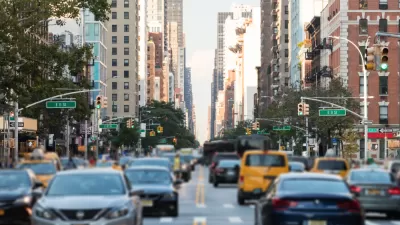An op-ed by Jostein Solheim, CEO of Ben & Jerry's, supports the second phase of greenhouse gas emissions and fuel efficiency standards for medium- and heavy-duty engines and vehicles that would become effective 2018.
I'm not sure how widespread in the corporate world the attitude expressed by Solheim and Ben & Jerry's is toward reducing carbon emissions, which they refer to as climate justice, but it's nice to read it in any case. The new rule, proposed June 19, stems from President Obama's decision to make climate change a legacy of his administration through executive action and rule-making by Environmental Protection Agency (EPA) and the National Highway Traffic Safety Administration (NHTSA).
"As the planet gets warmer, we at Ben & Jerry’s want to be sure that our ice cream is produced with as few greenhouse gas emissions as possible, to keep our fans supplied with Cherry Garcia without making climate change even worse," writes Jostein Solheim
We’ve done our homework and know that 17% of our carbon footprint comes from transportation, from shipping our ice cream from the factory to our distribution centers.
Heavy over-the-road trucks move 70% of America’s freight, yet these trucks average only six miles per gallon, are the fastest-growing single source of carbon pollution in the US, and truck travel is projected to increase 40% by 2040 [EIA: Annual Energy Outlook 2014 (PDF)].
More corporate support
Indra K. Nooyi, Chairman and Chief Executive Officer, PepsiCo, with Fred Krupp, President of the Environmental Defense Fund.
The Phase Two rule will apply to trucks built from 2019 to 2027, and will be finalized next year. Phase One rules [PDF] adopted in August 2011 applied to vehicles built for the 2014 to 2018 model years.
Hat tip: Jesse Prentice-Dunn, representative for the Sierra Club's Responsible Trade Program.
Correspondent's note: While it's great to see increased fuel efficiency and reduced greenhouse gas emissions, it would be even better to see advocates also mention the need to increase fuel taxes to compensate for reduced transportation revenue from "driving further on a gallon of gas or diesel."
FULL STORY: I scream, you scream, we all scream - for higher fuel emission standards

Planetizen Federal Action Tracker
A weekly monitor of how Trump’s orders and actions are impacting planners and planning in America.

Maui's Vacation Rental Debate Turns Ugly
Verbal attacks, misinformation campaigns and fistfights plague a high-stakes debate to convert thousands of vacation rentals into long-term housing.

Restaurant Patios Were a Pandemic Win — Why Were They so Hard to Keep?
Social distancing requirements and changes in travel patterns prompted cities to pilot new uses for street and sidewalk space. Then it got complicated.

In California Battle of Housing vs. Environment, Housing Just Won
A new state law significantly limits the power of CEQA, an environmental review law that served as a powerful tool for blocking new development.

Boulder Eliminates Parking Minimums Citywide
Officials estimate the cost of building a single underground parking space at up to $100,000.

Orange County, Florida Adopts Largest US “Sprawl Repair” Code
The ‘Orange Code’ seeks to rectify decades of sprawl-inducing, car-oriented development.
Urban Design for Planners 1: Software Tools
This six-course series explores essential urban design concepts using open source software and equips planners with the tools they need to participate fully in the urban design process.
Planning for Universal Design
Learn the tools for implementing Universal Design in planning regulations.
Heyer Gruel & Associates PA
JM Goldson LLC
Custer County Colorado
City of Camden Redevelopment Agency
City of Astoria
Transportation Research & Education Center (TREC) at Portland State University
Jefferson Parish Government
Camden Redevelopment Agency
City of Claremont




























